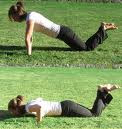‘Tis the season to make a goal for 2011. But seriously, New Year’s Resolutions aren’t hard to make, they’re hard to keep. In fact the NYR fail rate is around 90%...wowzer! So if you’re planning on making a fitness, financial or career or personal goal/resolution, make sure to make a plan! The first step is to make a resolution that has a chance! Follow these 4 simple rules when making your New Year's Resolution (NYR) and get ready to reach your goal!
- Set a goal. According to Psychology Today, if you make a resolution, you are 10 times more likely to succeed the desired outcome. So write your resolution down in specific terms. (ex: I will lose 15 pounds by June 1st. I will quit smoking using the patch by March 15th, I will put $100 into a savings account every month.)
- Be reasonable. Just as important as setting your goal is making sure that your goal possible and something that you want to do. If eating more fruits and veggies does not appeal to you on any level do not make your resolution to eat more fruits and veggies just because you know it’s good for you. If you want to lose weight, remember that you can only safely lose 1-2 pounds per week, so don’t make your goal to lose 100 pounds by February 2010. If you make $1,000 per month, don’t make your resolution to save $500 per month. Setting goals like this will just ensure another failed NYR. Find something you can be passionate about and go for it.
- Have a game plan. Sure you have your ultimate end-game goal, but knowing how you’re going to get there is super important. This might mean hiring a personal trainer, joining a gym, signing up for a weight loss program, buying nicotine patches or doing research about how to make your goal on the Internet or at the library. Whatever you do, make sure that you have the tools to achieve your goal.
- Start NOW. Yes…that’s right…do not wait until January 1st…start today. Whether it’s saving a specific amount of money every week or eating a certain number of fruits and veggies a day, start it now. Maybe not even full force, but use this week to ease into your goal.
Good luck and a happy rest of 2010!
Do you have a question about fitness that you would like answered? Just post your question in the comments section of this post or e-mail me directly at erin@ehfitness.com.









